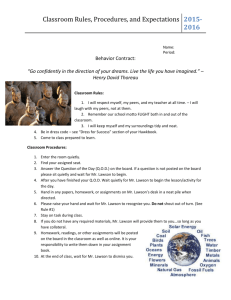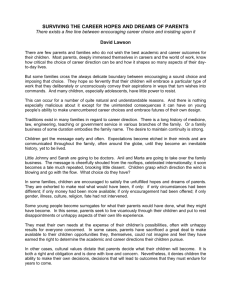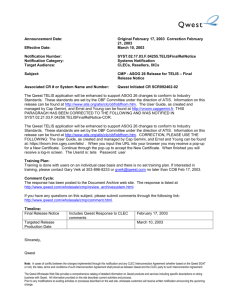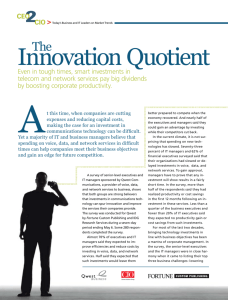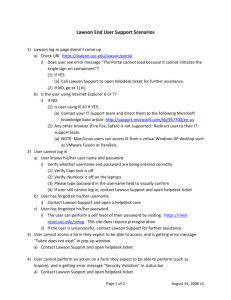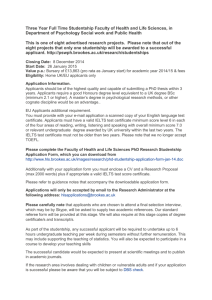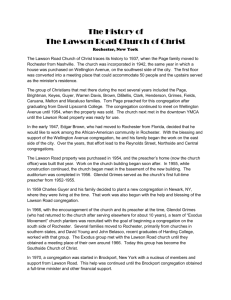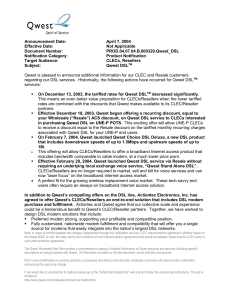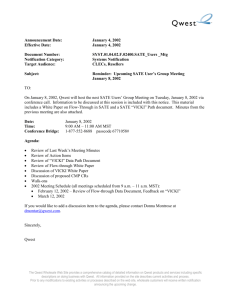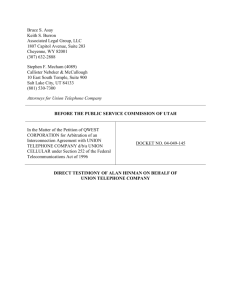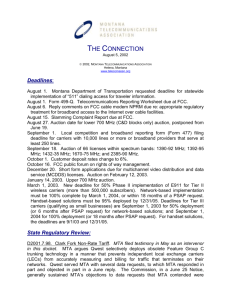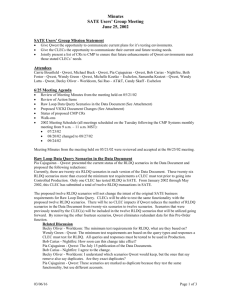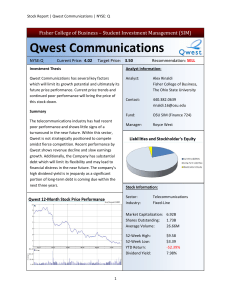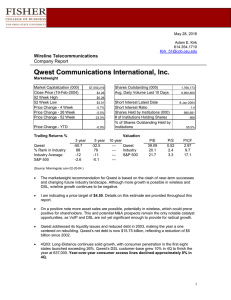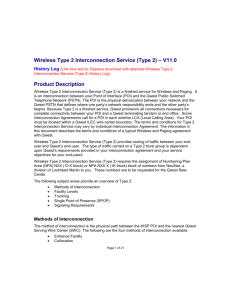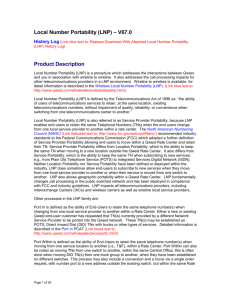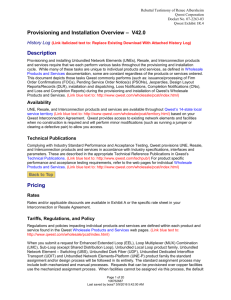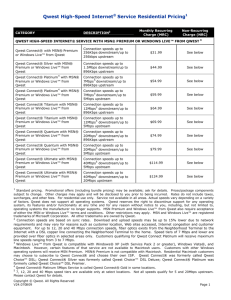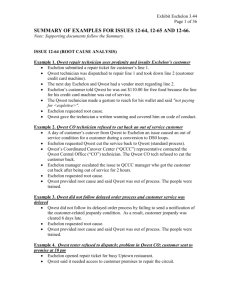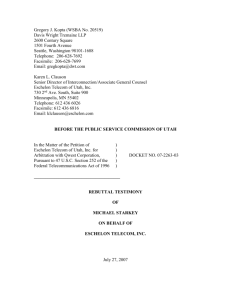case study in accounts receivable management using lawson software
advertisement
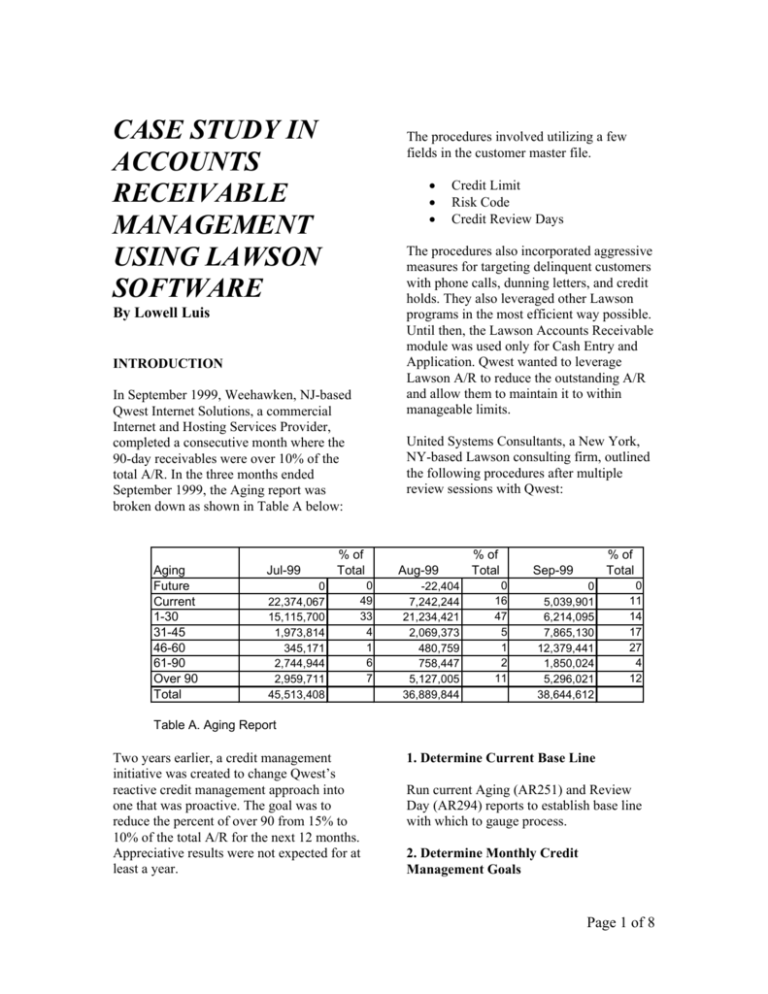
CASE STUDY IN ACCOUNTS RECEIVABLE MANAGEMENT USING LAWSON SOFTWARE The procedures involved utilizing a few fields in the customer master file. • • • The procedures also incorporated aggressive measures for targeting delinquent customers with phone calls, dunning letters, and credit holds. They also leveraged other Lawson programs in the most efficient way possible. Until then, the Lawson Accounts Receivable module was used only for Cash Entry and Application. Qwest wanted to leverage Lawson A/R to reduce the outstanding A/R and allow them to maintain it to within manageable limits. By Lowell Luis INTRODUCTION In September 1999, Weehawken, NJ-based Qwest Internet Solutions, a commercial Internet and Hosting Services Provider, completed a consecutive month where the 90-day receivables were over 10% of the total A/R. In the three months ended September 1999, the Aging report was broken down as shown in Table A below: Aging Future Current 1-30 31-45 46-60 61-90 Over 90 Total Jul-99 0 22,374,067 15,115,700 1,973,814 345,171 2,744,944 2,959,711 45,513,408 Credit Limit Risk Code Credit Review Days United Systems Consultants, a New York, NY-based Lawson consulting firm, outlined the following procedures after multiple review sessions with Qwest: % of Total 0 49 33 4 1 6 7 Aug-99 -22,404 7,242,244 21,234,421 2,069,373 480,759 758,447 5,127,005 36,889,844 % of Total 0 16 47 5 1 2 11 % of Total Sep-99 0 5,039,901 6,214,095 7,865,130 12,379,441 1,850,024 5,296,021 38,644,612 0 11 14 17 27 4 12 Table A. Aging Report Two years earlier, a credit management initiative was created to change Qwest’s reactive credit management approach into one that was proactive. The goal was to reduce the percent of over 90 from 15% to 10% of the total A/R for the next 12 months. Appreciative results were not expected for at least a year. 1. Determine Current Base Line Run current Aging (AR251) and Review Day (AR294) reports to establish base line with which to gauge process. 2. Determine Monthly Credit Management Goals Page 1 of 8 Based on current cash flow requirements, determine the necessary collection and past due percentage reduction goals for the month. Laura Andolini of Qwest explained, “We should always target A/R over 90 days since this money is excessively overdue and we cannot borrow against it. However, when our cash flow is tight we will see the most rapid responses from our lower risk customers with A/R over 45 days overdue. We should adjust our target criteria accordingly to meet our cash flow needs. With the Lawson modifications in place, we will have the ability to identify and select customers based on the percentage of their A/R in specific aging periods. We should use these tools to track and gauge customers who are at risk of having 50% of their A/R go over 90. Since we lose the ability to borrow against any of the A/R once this happens, we should make collecting from these customers a priority.” 3. Determine Credit Review Selection Criteria1 Based on needs determined in step 2 above, set criteria for customer selection. Determine risk codes, past due amounts, and customers. 4. Based on Selection Criteria, Generate Collection Target List Run Customer Review Selection (AR170) to generate target list. This program will be modified to make the management approach much more effective. The modified report accomplishes the following objectives: a. Target customers based on the percentage of their total A/R in a specified aging period. 1 Qwest decided to select customers with 50% of their A/R over 45 days. For example, customers with 40% of their total A/R between 60 and 90 days overdue. b. Target customers based on the percentage of their Credit Limit in a specified aging period. For example, customers with 70% of their total Credit Limit between 60 and 90 days overdue. The consultants explained: “Without the percentage calculations, only fixed amounts of over 90 can be selected. This is not practical since a client that has a total A/R of $100,000 and over 90 of $5,000 is much less delinquent than a customer with total A/R of $7,000and over 90 of $5,000.” c. Target customers based on risk codes. Specifying Risk codes in the parameter will narrow the selection further. For instance, one could target higher risk customers as soon as their A/R goes over 30. 2 5. Make Phone Calls and Log Customer Responses After utilizing Lawson’s Customer Review Selection Report (AR170) to generate the list of customers to call, manage the call using Lawson’s customer comments screen. Ms. Andolini noted, “This is not our current method for making and logging calls. This change will allow us to use our time more effectively”. 6. Log Activity and Results Use tracking spreadsheets to measure attained goals. 2 Qwest has decided to target high-risk customers (Risk Codes 7, 8and 9) as soon as 1% of A/R goes over 30. Page 2 of 8 company also offered web hosting and colocation services, web-enabled enterprise solutions, consulting, and vendor valueadded services. Subscribers to the non-IP services accounted for the most increase in their customer base. IMPETUS FOR CHANGE Since its founding as Icon CMT Corp, Qwest Internet Solutions, Inc., a subsidiary of Qwest Communications Corp., has provided single-source, end-to-end internet solutions to clients. Its nationwide highspeed IP backbone network was designed specifically to support business applications. In September 1999, revenues were broken down as shown in Table B below. As the internet played a more significant role in business and industry, more and more companies were seeking to leverage the maturing IP technologies to bring their companies on-line. In this regard, they chose Qwest as the provider of choice. The Net Revenue In the ever-quickening evolution of online companies, Qwest took on more and more customers. Its customer base, originally in the established financial services industry, became a “who’s who” of the online services arena. Also in the list of players were start-up companies with no credit Current YTD % Net Sales Prior YTD % Net Sales Products Proprietary Hardware Proprietary Software Non Proprietary Hardware Non Proprietary Software Freight Income Total Products 226,000 50,199 35,381,199 13,584,692 217,475 49,459,565 0.2 0.1 38.6 14.8 0.2 53.9 240 0 19,862,717 4,045,730 195,271 24,103,958 0 0 37.9 7.7 0.4 46 Communications Hosting Network Access Local Loop Charges Setup Charges Hosting Support & Maintenance Domain Registration Revenue Bell Atlantic Network Access Dedicated Revenue Dialup Revenue Shared Web revenue Sales Discounts & Allowances Total Communications 3,010,015 4,978,398 1,451,034 136,743 85,909 74,215 900,000 3,622,569 1,680,938 58 80,000 16,019,879 3.3 5.4 1.6 0.1 0.1 0.1 1 4 1.8 0 0 17.5 1,952,175 3,214,709 1,031,413 255,333 125,320 14,200 350,000 1,276,924 1,626,441 28,929 0 9,875,444 3.7 6.1 2 0.5 0.2 0 0.7 2.4 3.1 0.1 0 18.8 Professional Services Professional Services Total Professional Services 26,201,766 26,201,766 28.6 28.6 18,400,642 18,400,642 35.1 35.1 Table B. Year-to-date Revenue Page 3 of 8 history. A few of these “dot-coms” were defaulting on their payments. Some had already gone out of business. references, and in the case of existing customers, reviewing their payment history using AR71 (Customer Summary). In the influx of customers, sales initiatives superseded credit policies. The finance department had been pressured to open, extend credit, or resale an account that was not credit worthy. This resulted in some customer balances that were stretched out all over the aging. And although credit reviews were part of the sales process, there were a lot of exceptions and special situations. As one executive declared, Qwest has decided to extend a credit line equal to 10% of a customer’s balance sheet equity. • “I keep a red folder on my desk for all important matters that need attention now. We had a $50,000 order for the City of LA that needed special handling – I reviewed the credit within 20 minutes and had the product shipped within the hour. We could not allow credit policy, as written, to get in the way of that order”. Based on historical monthly average DBT information, the analyst should be able to detect customer trends and adjust risk codes accordingly. The consultants added: Furthermore, the sales department had permission to offer a customer extended terms per invoice. In this scenario, the profitability of an overdue account will have decreased while the DSO (Days Sales Outstanding) will have increased.3 “If a customer’s year-to-date DBT were 20, it would not appear that they are a high risk. However, by looking at the monthly DBT average, it may be seen that for the first half of the year, payments were made immediately but for the last three months, payments have become excessively late. While the year-to-date DBT may be low, the current failure to pay may signal CUSTOMER REVIEW In Lawson, the customer review process involved the following: • 3 Assigning a credit limit – this is done by reviewing the Dun and Bradstreet Express and Experian Intelliscore reports, doing a bank analysis, checking bank and credit Days Sales Outstanding is computed as the Current Period A/R total divided by the Current Period Sales; the result is multiplied by the number of days in the current period. Assigning risk codes – Lawson allows assigning risk codes from 1 through 9. These risk codes will be used in running a custom-developed Automatic Credit Hold Update program to assign a hold code in AR10 (Customer Master). The risk codes will be based on monthly and year-to-date information obtained from AR75 and a custom-developed DBT (Days Beyond Terms) report.4 4 DBT is calculated as follows: 1. Calculate the days outstanding by subtracting the due date from the date of payment deposit. 2. Calculate the flow of funds by multiplying the days outstanding by the payment amount. 3. Add the payment amount for all invoices. 4. Add the flow of funds days for all invoices. 5. Divide the total flow of funds days by the total payment amount. Page 4 of 8 that the company is running out of money and their risk code should be updated to reflect this”. The following matrix was used to assign risk codes to current customers: Average DBT 0-30 31-45 46-60 61-90 91+ Risk Code 1 3 5 7 9 Risk Code Key: 1 = Customers that present little to no risk 3 = Customers who present a low risk 5 = Customers who present a moderate risk 7 = Customers who are a high risk 9 = Customers who are chronically late All new customers were assigned a risk code of 7. • all the risk codes, credit limits, review days and auto dunning defaults. This is necessary because the reports we have created for our new A/R procedures will be referencing this information.” COLLECTION STRATEGIES A very high percentage of collection accounts were due to discrepancies or grievances that were never solved. To circumvent this problem, the Sales department played a major role in cleaning up many of these collectibles. By allowing the benefit of the doubt on the first collection call, 30% of receivables were collected by asking, “is there a check on its way?” or “is there a problem that I can help you with?”. As an added incentive, Qwest Internet Solutions historically has paid sales commissions based on collections. Setting credit review days – for existing customers in good standing, credit reviews should be done annually. For new customers it should be done every 3 months for the first year and for high-risk customers every 2 months so that the risk codes can be updated and credit limits adjusted (set to 90 or 60 days accordingly). By setting this field, the system will track and notify the credit analyst when a customer is scheduled for their next credit review. Ms. Andolini explained, From the outset, Qwest has also put customers on payment options that include Cash-On-Delivery and Cash-In-Advance. These features are available in Lawson visà-vis OE10 (Order Entry): COD invoices cannot be re-printed; CIA invoices print a zero net total. Accordingly, “Currently most of our customers have not been reviewed since they were initially added to the system. This being the case, it is imperative that the first step in implementing these procedures be to go through our customer database and update Even with the above collection strategies, the review sessions between Qwest Internet Solutions and United Systems Consultants created actual guidelines for monthly processing: “Customers may not like COD, but they cannot dislike not paying service and late charges and receiving their shipments when requested.” Qwest, however, very rarely imposed finance charges. 1. Generate Dunning Letter Text Page 5 of 8 Qwest used three different dunning letter texts. The first letter was a reminder to the customer that their payment is late. The second letter stated the same but in stronger language. The third indicated that the failure to pay would result in the customer’s account being placed on hold. In Lawson, dunning texts were entered in AR18 with corresponding text numbers. Auto-dunning was turned on for customers in AR10. Ms. Andolini explained, “I found that especially for customers with low risk codes, dunning letters do result in a payment response. They also create an influx of requests for invoices sent to wrong locations or lost by the customer. While the list of customers selected for phone calls should be specific for our needs, dunning letters should be sent to all customers with outstanding accounts receivable”. 2. Determine Selection Criteria for Dunning Letter Creation In Lawson, AR160 defined the criteria for generating dunning letter. The three different dunning letters were assigned based on the following criteria: Dunning letter 1 was assigned to customers with A/R just over 30days. Dunning letter 2 was assigned to customers with A/R just over 45 days. Dunning letter 3 was assigned to customers being placed on credit hold. AR161 was run to actually print the letters. To increase their effectiveness, statements were also attached. Statements are printed using AR150. 3. Analyze and Measure Dunning Letter Effectiveness Qwest used tracking spreadsheets to measure response rates. 4. Determine Auto-Hold Selection Criteria The custom-developed Auto Hold Form allowed the analyst to automatically place customers on hold based on the percentage of their Total A/R or Total Credit Limit in a specified aging period. The program also allowed filtering by risk codes. The following criteria was established to put customers on hold: Risk Codes % of A/R 1-6 1-6 1-6 1-6 7-9 7-9 50 % of Credit Limit 50 25 25 25 25 Over Due Period 45 > 45 > 60 > 60 > 45 > 45 > Hold Code ARH1 CLH1 ARH2 CLH2 ARH3 CLH3 In Lawson, Hold Codes were maintained in AR16. 5. Run Auto Hold Program The custom-developed Auto Hold Update program reads the criteria established in the Auto Hold Form mentioned above. The program then puts a hold code on the customer record. The customer’s subsequent orders entered in Order Entry (OE10) and invoices entered in Billing Entry (BL20) will consequently be put on hold. There was logic built in such that the program will skip customers who are exempt from auto hold for a given period, e.g. in cases where a promise of payment has been made. A “Hold Exception Date” field has been added to the Customer Defaults screen (AR10.3). The analyst may enter a date in this field until which time the customer will be excluded from the autohold selection process. Once the “Hold Exception Date” is reached the customer Page 6 of 8 will again be tested for the auto-hold criteria and be subject to credit hold. Statistics indicate that more than 10% of over 90 do not get collected. 6. Analyze and Measure Auto-Hold Responses In the end, invoice volume also became a problem. Less cumbersome policies and procedures were tried, with varied success. Among them: Qwest used tracking spreadsheets to measure productivity of credit holds. The analyst removed holds when payments were received; otherwise, the credit hold will remain. 2. Faxing invoices directly from the Lawson system to clients. CONCLUSION The credit management initiative produced mixed results due to lack of commitment and follow-up. Over the course of the following year, turnovers in the Finance and Sales departments, as well as in Executive Management, became rampant. The meticulous procedures for credit management enjoyed as much support as disdain. In October 1999, A/R over 90 as a percent of total A/R was back at the same level when the initiative began: Aging Future Current 1-30 31-45 46-60 61-90 Over 90 Total Oct-99 0 2,970,742 6,745,231 7,315,249 12,644,391 2,043,597 5,635,034 37,354,244 % of Total 0 8 18 20 34 5 15 While the Aging amounts subject to General Reserve were: Current 1-30 31-45 46-60 61-90 Over 90 1. Receiving cash receipts from the bank using Lawson’s lock box and payment electronic interfaces. 0.50% 0.75% 1.00% 2.00% 3.00% 5.00% 3. Giving sales representatives training in and access to Lawson. 4. Prospecting customers only if their Experian Intelliscores are above acceptable risk levels. 5. Evaluating the service level agreements periodically for loopholes in contract terms and conditions. 6. Asking the client for three contact names: the highest-ranking employee, the requisitioner, and the A/P contact. 7. Imposing finance charges utilizing Lawson’s features in that area. 8. Negotiating anything (e.g. rebates, quantity discounts, etc.) but payment terms. In January 2000, Qwest Communications Corporation centralized their Finance and Accounting functions. Qwest Internet Solutions’ Credit department, among others, went to Denver, CO while Billing and Accounts Receivable for Professional Services remained in Weehawken, NJ. Page 7 of 8 _________________________________ This case was prepared as the basis for problem study rather than to illustrate effective or ineffective handling of an administrative situation. Certain company data have been disguised. Lowell Luis is Partner and Co-Founder of Focus5, Inc., a management and technology consulting company specializing in Lawson Software. Prior to founding Focus5, Lowell Luis worked for United Systems Consultants and Qwest Internet Solutions. He has a computer science degree from Queens College and an MBA from Rutgers University. He can be reached at luis@focus5inc.com. Copyright © 2001 by Lowell Luis. No part of this publication may be reproduced, stored in a retrieval system, used in a spreadsheet, or transmitted in any form or by any means---electronic, mechanical, photocopying, recording, or otherwise--without the permission of the author. Page 8 of 8
